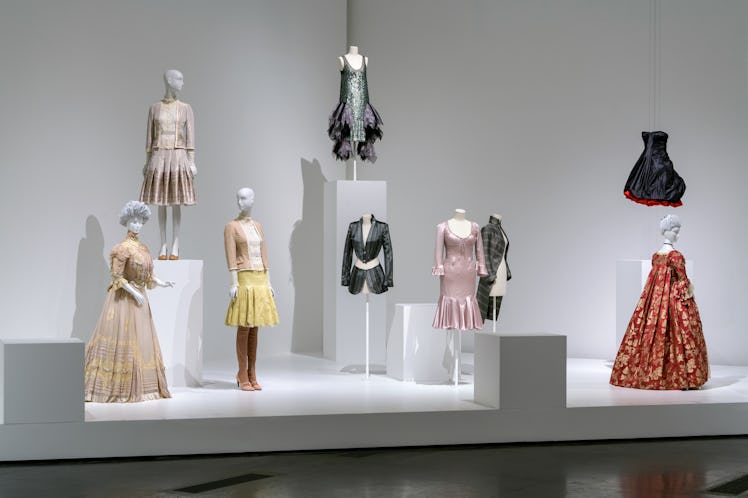Fashion retrospectives can be thorny affairs. It takes a deft touch to shoehorn the vision, creativity, and life’s work of a designer into a cohesive exhibit that delivers probing insight without feeling like you’re simply touring a magazine’s fashion closet.
Which speaks to the triumph that is the newly opened Lee Alexander McQueen: Mind, Mythos, Muse, on view through October at the Los Angeles County Museum of Art. The show aims to throw a lasso around the chimerical career of the rules-breaking British couturier the Times of London once labeled “the hooligan of English fashion.” Bursting onto the style scene in the 1990s, McQueen eventually worked as head designer for Gucci and partnered with Givenchy before winning CFDA’s Designer of the Year Award in 2003, only to die of suicide in 2010 at the age of 40. Upending the industry with a flair that married a Slim Aarons aesthetic with glittery Bob Mackie pizzazz, McQueen crafted clothes that were trailblazing, polarizing, and relentlessly interesting. As the new exhibit showcases, they were also influenced by myriad works across the artistic spectrum.
Installation photograph, Lee Alexander McQueen: Mind, Mythos, Muse, Los Angeles County Museum of Art, April 24–October 9, 2022, photo © Museum Associates/LACMA
Indeed, the genius of the LACMA show lies in its refusal to try and make sense of its subject’s hectic biography. Consisting of three long, wide corridors of wearable eye candy collocated by Clarissa Esguerra, the associate curator of Costume and Textiles, and curatorial assistant Michaela Hansen, it instead opts to pair McQueen’s kicky designs with objects from the museum’s permanent collection to mine the designer’s inspirational touchpoints. It’s a bold approach to exploring his complex legacy, which, more than a decade after his death, continues to evolve. “I think it really highlights his various sources of inspiration, and how he was truly a student of the world: his depth of knowledge, his depth of referencing,” Esguerra says. “A lot of people tend to look at the macabre aspects and death in his work. But if you’re looking at his objects and read what he said in previous interviews, he always said, ‘In death, there’s life.’ We wanted to celebrate that.”
And do they. Divided into four distinct sections—Mythos, Fashioned Narratives, Technique and Innovation, and Evolution and Existence—those three promenades empty into an expansive gallery that gives one the feeling of being in a particularly stylish fun house. The entire experience manages to both celebrate the dark mirth that informed McQueen’s designs while also paying respect to his seriousness as a craftsman. “McQueen was inspired by Goya. Picasso was also inspired by Goya, you know?” Esguerra says. “There are these cycles that happen in all artists. And McQueen is a wonderful case study.”
Alexander McQueen, Woman's Dress (detail) from The Widows of Culloden collection, Fall/Winter 2006-07, Los Angeles County Museum of Art, gift from the Collection of Regina J. Drucker in honor of Joseph and Genevieve Venegas, photo © Museum Associates/LACMA
Frans Pourbus II, Portrait of Louis XIII, King of France as a Boy, c. 1616, Los Angeles County Museum of Art, gift of Mr. and Mrs. William May Garland, photo © Museum Associates/LACMA
Featuring more than 70 designs “in conversation” with the museum’s paintings, textiles, costumes, photographs, and sculpture, the show transcends McQueen to provide larger commentary on the intersection of art and luxury: Sly metallic stilettos (with heels in the shape of naked temptresses) are exhibited with a 15th Century sculpture of Florentine seraphim; a silk plain-weave crepe with crystals stands guard over 19th Century cerulean tapestry; a silk, tulle, and satin A-line with metal sequin embroidered appliqués is an amusing foil for an 1820 gown with metal strip embroidery and a silk gauze weave. The more you think things don’t go together, the more they do. It’s a gamification of fashion that McQueen would have adored.
In the end, it is, of course, the clothes—gifted by Pasadena socialite Regina Drucker in 2015 as part of a formidable bequest that also included Fortuny, Charles James, and Balenciaga—that spellbind. And while many indeed seem directly inspired by ago works of art, others seem more rooted in recent 20th Century flair: A champagne-colored silk chiffon baby doll dress, trimmed in feathers with a metallic-thread braid at the collar, could easily have taken its inspiration from Audrey Hepburn at a party on the Côte d’Azur in the 1960s; a flowing vanilla crepe floor-length shift gives vibes of Marisa Berenson draped in Halston in the ’70s. You get to peregrinate through a fever dream of glamour from whatever era you choose.
Installation photograph, Lee Alexander McQueen: Mind, Mythos, Muse, Los Angeles County Museum of Art, April 24–October 9, 2022, photo © Museum Associates/LACMA
It would be derelict not to mention the literal cherry on top of LACMA’s delicious McQueen sundae: the whimsical headpieces crafted by L.A. designer Michael Schmidt, whose accessories have adorned the likes of Lady Gaga and Madonna. Among the treasures: a Mad Men-ish gold leaf and paper mâché headdress; a gray wool knit and metal cap with embroidered Mercury wings; a leather herringbone twill weave helmet that conjures Cher’s infamous Mohawk at the 1986 Oscars. “He’s known for using 3-D printing technology, and so like McQueen, he shares that kind of interest in pushing boundaries in terms of materials,” Hansen says of Schmidt, whom the museum commissioned for the exhibit. “We were excited to bring that element into the display.”
McQueen once famously declared, “I never look at other people’s work. My mind has to be completely fixed on my own illusions.” Transcending hagiography, the LACMA exhibit seems to intriguingly argue otherwise, while celebrating a designer whose short but brilliant body of work manages to still conjure effulgent illusions of its own.
This article was originally published on
